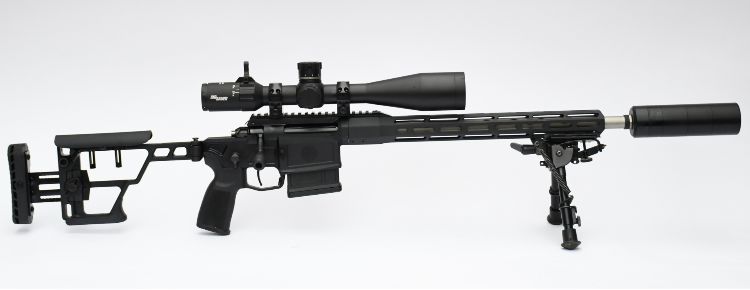 It seems a long time since I first encountered the Sig Sauer Cross rifle – sometime before the Covid wilderness – but finally I have one. This rifle has been very well received in the US, where Sig advertise it as a “Precision hunting bolt-action rifle”, so I was keen to see how it fits into the UK market.
It seems a long time since I first encountered the Sig Sauer Cross rifle – sometime before the Covid wilderness – but finally I have one. This rifle has been very well received in the US, where Sig advertise it as a “Precision hunting bolt-action rifle”, so I was keen to see how it fits into the UK market.
According to the company, the rifle was designed and built from the ground up by Sig Sauer at their research and development facilities in New Hampshire, with input from hunters, military snipers and elite long-range shooters. The Cross rifle was created to meet the demands of both precision long-range shooting and extreme ‘backcountry’ hunting, which we would perhaps translate to hill stalking. Compact size and light weight were clearly priorities, immediately striking you as soon as you open the box. With its short 406mm/16" barrel in .308 and 2.94 kg/6.5lb overall weight, you would imagine it to be very lively, but in this regard I was pleasantly surprised.
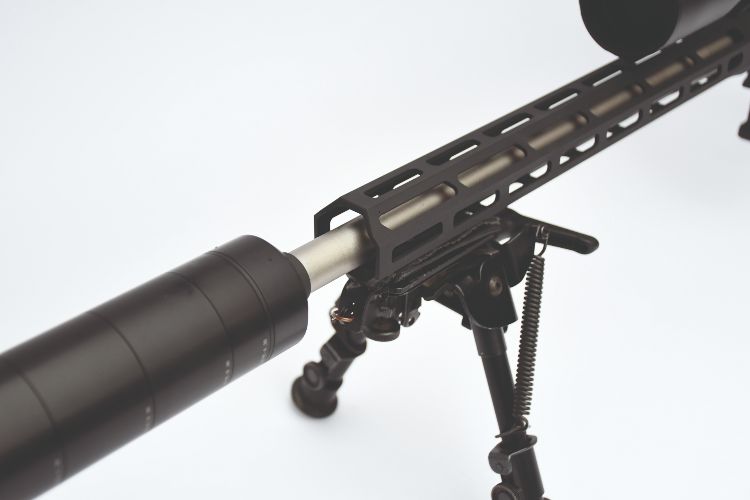 An unusual design
An unusual design
The stainless-steel barrel is 18mm in diameter just behind the 5/8x24 threaded muzzle. It is supplied with a thread cap and spacer that needs to be fitted between any muzzle accessories and the barrel thread’s shoulder to compensate for the slightly tapered profile. The barrel has a 1 in 10" twist, which sounds good to me as I always prefer to use heavier/longer bullets in short barrels to maximise muzzle energy.
The barrel disappears into the hexagonal forend, which is riddled with cutouts for cooling and M-Lok compatibility. It’s stiff and problem free, with a 375mm/14.75" length reaching forwards from the action. No sling studs are supplied, but M-Lok invites the addition of whatever accessories you desire to the 39mm width and height.
Here the design becomes very unusual, and from a modern engineering perspective, rather pleasing. The forend bolts to the action/receiver, which is itself a one-piece machined component incorporating an AICS compatible magazine well, action raceways and trigger guard, and terminates behind the tang with the frontal section of the buttstock’s steel hinge bolted in place. This is not often seen; even an AR-15 has upper and lower sections.
Scope mounting is handled by an additional Picatinny rail that runs the full length of the action and extends onto the forend giving 190mm/7" of space for your chosen mounts and optic, so you won’t have any problem accommodating comfortable eye relief. Other than the barrel, bolt and a few fasteners, nearly everything is matt black anodised aluminium, which is largely responsible for the low weight.
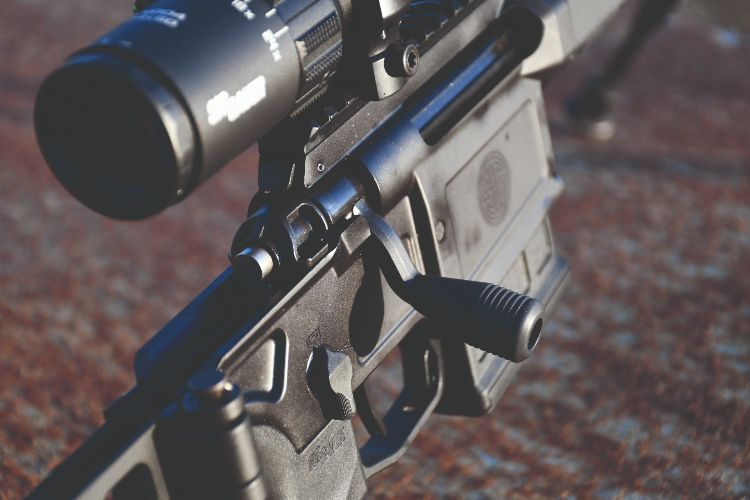 Action and magazine
Action and magazine
Inspection of the bolt shows that it has a simple push-feed mechanism with a single upper-right-side extractor claw and a lower-left spring-plunger ejector pin. There are three lugs enabling 60° bolt operation, cocking as it lifts. The blackened steel bolt runs incredibly smoothly in the hard anodised action. It has an unusually shaped bolt handle with an outward kink that presents the 19mm teardrop-shaped, hard-anodised aluminium knob right to your fingers. The bolt head is a separate component from the shaft itself, which carries seven raceways that interact with the upper bolt-release catch and minimise friction with receiver internals.
You need to fold the stock to remove the bolt from the action by pressing a button at the back of the action, just above the bolt shroud’s cocked action indicator. It’s an unusual location but is still perfectly functional. The stock/receiver is channelled all the away to the hinge to retain the bolt’s linear stroke, and this is yet another beneficial contributor to smooth travel that won’t jam.
Sig supply a five-round polymer P-Mag with the rifle. It is compatible with the AICS format, although the P-Mag does show a little more detail on its orange polymer follower than most AICS magazines. It has a slight ramp at the front to help lift the shoulder of the last case in its single column when pushed forward.
Single rounds are slid in from the front of the magazine to load it. It is smooth in operation and I had no misfeeds. Automated ejection was reliable. Single rounds dropped into the ejection port will feed straight into the chamber with minimal assistance. As an aside, it’s worth checking that the mag is fully engaged in the action, as the tolerances on the well are snug and the mag will hold in position without being fully clicked into place. The orange follower makes it easy to see if the magazine is empty and the removal catch is easily accessed just in front of the trigger guard.
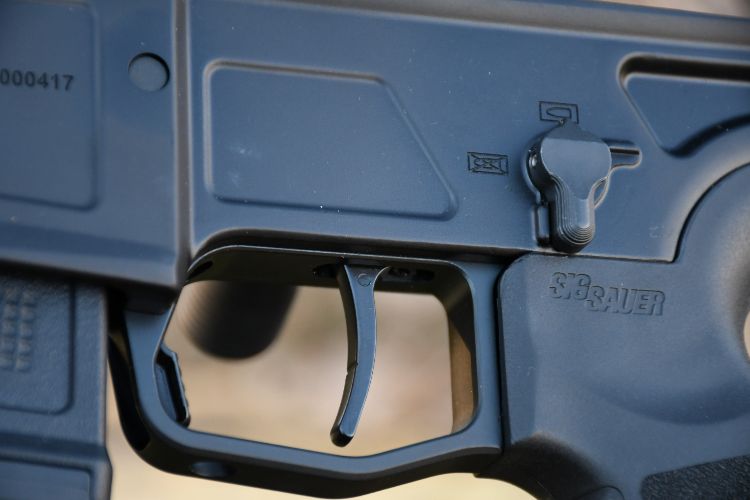 Trigger and safety
Trigger and safety
The trigger is a two-stage match unit and on the review rifle broke crisply at 1100gr/39oz, which seems realistic for a hunting rifle. The blade is a little unusual, being quite straight, but mostly because it is a folded steel channel where we often see aluminium used. I can see the reasoning, as in aluminium it would be too easily damaged, and regardless it complements the looks of the rifle and the overall build character. It would appear to offer adjustment although this is not advertised, as there are Allen screws accessible in front of the blade within the trigger guard.
The safety catch is an ambidextrous thumb lever above the AR-15 type grip. It flicks to vertical for fire and horizontal for safe using the firing hand’s thumb. It does not lock the bolt. The action/receiver carries multiple machined rebates to save weight and break up what could have been a slab-sided looking rifle without them. Everything is radiused, with no sharp edges, and deeply anodised with no hint of any machining marks or texture in what is probably a bead-blasted component. The underslung polymer grip has stippling moulded in for added grip and purchase without requiring the user to cling on too hard. With a 70mm span from its throat to the trigger blade, it has the usual AR-15-style short-reach ergonomics.
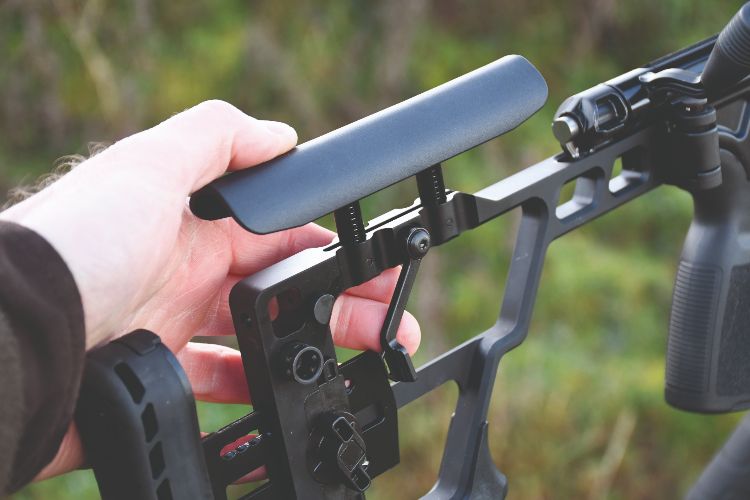 Stock
Stock
The stock is unfolded with a press on the steel hinge mechanism’s upper button, allowing it to swing out straight where it relocks. The steel jaws on the hinges bolt to the receiver and butt with a steel hinge pin to join the two. The hinge latches closed firmly without play, but if the gun were mine I’d have the Torx screws that attach them to the aluminium torqued up and threadlocked to guard against them ever coming loose.
It didn’t really occur to me at first, but with a folding stock I suppose there is the possibility someone might shoot the gun folded or when not latched correctly into position. Sig minimise the first possibility by having the stock fold 180° round to the right and lock in position with the bolt handle enclosed where it slots through the cutout under the comb. The other possibility is minimised by the bolt not easily operating with the stock unlocked. The hinge mechanism prevents the striker passing cleanly back and forth unless locked straight.
Length of pull reaches from 325mm/12.75" to 375mm/14.75" and is altered by means of a simple but effective S-shaped thumbscrew. Small features like this really impress me because it is so much easier to use than a round knurled knob. Well done, Sig!
The rubber recoil pad is medium-hard and again shows intelligent design. It has a solid centre to transfer recoil, with slots around the edges for incredible comfort and pliability without the annoying spongy feel that’s so commonly assumed to make a rifle less aggressive.
The recoil pad itself has 70mm of vertical travel along its steel carrier – another location where the material seems to have been chosen by an engineer rather than a marketeer. Steel never sounds as cool as aluminium but still has its place when material properties are paramount. There’s a QR sling anchor point just ahead of the recoil pad that can be flipped either side for rifle carry.
The comb is slender and height adjustable without any tools. Simply press the safety button, swing the locking lever down and the comb springs up to its maximum height with 25mm of travel. You can then put your cheek on it and push down until you get your ideal view through the scope, then lift the lever until it locks. That’s it. Delightfully functional with total security.
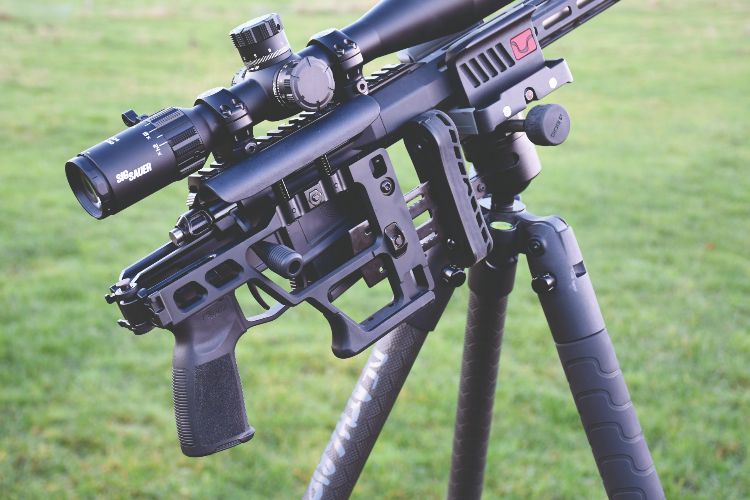 Shooting the Sig Sauer Cross
Shooting the Sig Sauer Cross
When I shot the Sig it surprised me because it had the most linear recoil path I can remember in any rifle. With a mod fitted there was just a pulse of pressure into the shoulder with almost zero muzzle jump. Without a mod it still remained impressive. Other great guns with similar characteristics were longer, heavier, braked and even in smaller calibres.
The Cross benefitted from none of these factors yet it was thoroughly pleasant to shoot from the bench, prone, off hand or from a tripod. This seems to be due to the barrel-to-stock linearity, because I hadn’t even lifted the recoil pad at this point, nor was I specifically welding my cheek in place. It just felt comfortable. Regardless of muzzle accessories, this makes shooting less physically demanding and also enables you to see bullet trace/impacts and quarry reaction far more easily.
In terms of ultimate performance, I can’t say that it shot single-hole groups, but they were in the right average position every time. I try to think of accuracy in a hunting rifle as a realistic range within which you can safely tackle a shot regardless of how roughly the rifle has been treated or mistreated, and however bad the shot position or scenario is.
The test rifle was brand new and initially I could just about achieve 2 MOA on a target at 100m. But after more ammo, more trials and more cleaning I managed the magic 1 MOA and stayed about there with factory ammo. I also cheated a bit and finished up with a favourite handload that I always find works if I’m struggling to prove a rifle, and yet again it did the business with a couple of half-inch groups. It’s a case of optimising ammo for the shorter barrel.
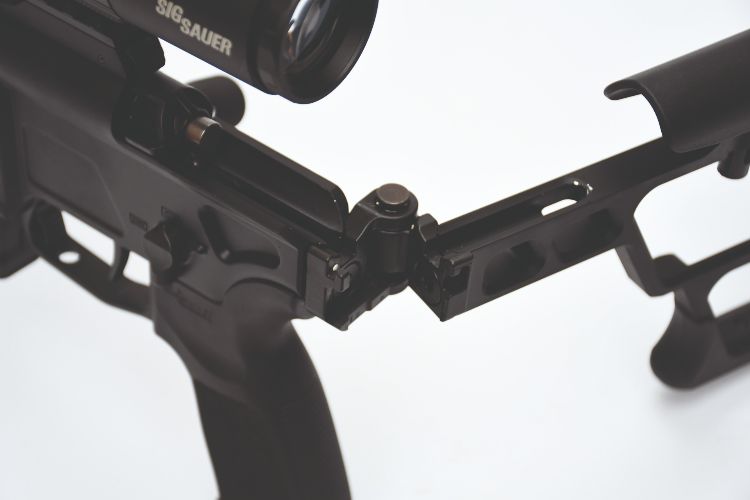 Conclusion
Conclusion
The Sig Sauer Cross is one of those rare rifles I can’t really place. It’s obviously designed around a US tactical-looking rifle for hunting, which is perhaps less likely to appeal in the UK. But for anyone who sees it as a light tactical rifle, and isn’t driven to seek ultimate precision, it’s still an accurate gun.
It’s innovative and appealing in terms of great handling, recoil control, bolt operation and stock ergonomics. On a light rifle in a realistically potent calibre for the UK, it shows just how beneficial good gun fit is to blend it to the ‘nut behind the butt’.
Tech specs
Calibre: .308 Win
Barrel length: 406mm/16"
Mags included: 5-round polymer P-Mag
Mag type: AICS compatible
Barrel material: Stainless steel, 1 in 10" twist rate
Trigger type: Two-stage match
Stock material: Black anodised aluminium
Overall length: 927mm/36.5" (660mm/26" folded)
Length of pull: 325-375mm/12.75-14.75"
Muzzle thread: 5/8"x24
Accessory rail: M-Lok
Weight: 2.94kg/6.5lb
Also used
Sig Sauer Tango 6-25x50 riflescope
Tier-One 30mm Picatinny scope rings
RCC end-of-barrel sound moderator
Contact
Highland Outdoors (for rifle and all products used)
01858 880491
www.highlandoutdoors.co.uk